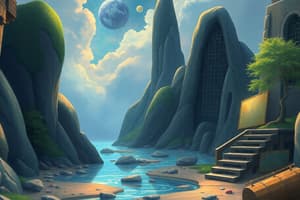Podcast
Questions and Answers
What does 'Allusion' refer to?
What does 'Allusion' refer to?
- An unexpected twist in a narrative
- A direct comparison between dissimilar things
- A reference contained in a work (correct)
- A brief narrative
Which of the following best describes 'Analogy'?
Which of the following best describes 'Analogy'?
- A literary device for comparison (correct)
- The author's attitude toward the subject
- A clash between opposing forces
- A brief narrative
What is an Anecdote?
What is an Anecdote?
A brief narrative or retelling of a story or event.
Define Antithesis.
Define Antithesis.
What does 'Audience' refer to in writing?
What does 'Audience' refer to in writing?
What is a Character in literature?
What is a Character in literature?
Describe Chronological Order.
Describe Chronological Order.
What is a Climax?
What is a Climax?
Define Conflict in literature.
Define Conflict in literature.
What is Dialogue?
What is Dialogue?
What does Figurative Language encompass?
What does Figurative Language encompass?
Explain Flashback.
Explain Flashback.
Define Hyperbole.
Define Hyperbole.
What is meant by Imagery?
What is meant by Imagery?
Define Irony.
Define Irony.
What is a Metaphor?
What is a Metaphor?
What is a Motif?
What is a Motif?
What is Parallelism?
What is Parallelism?
Define Personification.
Define Personification.
What does Physiognomy refer to?
What does Physiognomy refer to?
What is a Plot?
What is a Plot?
What is Point-of-View in literature?
What is Point-of-View in literature?
What refers to a writer's Purpose?
What refers to a writer's Purpose?
Define Regionalism.
Define Regionalism.
What is Resolution in literature?
What is Resolution in literature?
What is a Rhetorical Question?
What is a Rhetorical Question?
Define Satire.
Define Satire.
What is a Simile?
What is a Simile?
Define Stereotype.
Define Stereotype.
What does Symbol refer to in literature?
What does Symbol refer to in literature?
What is Theme in literature?
What is Theme in literature?
Define Tone.
Define Tone.
What is Verisimilitude?
What is Verisimilitude?
What are Comma Splices?
What are Comma Splices?
What are Commas used for?
What are Commas used for?
What are Fragments in writing?
What are Fragments in writing?
Define Run-on/Fused Sentences.
Define Run-on/Fused Sentences.
Flashcards are hidden until you start studying
Study Notes
Literary Devices and Terminology
- Allusion: Reference to literature, history, religion, or mythology within a work.
- Analogy: Comparison between two distinct items, suggesting a similarity in their relationships.
- Anecdote: A brief, often personal, story or retelling of an event to illustrate a point.
- Antithesis: Presentation of contrasting ideas, balanced through phrasing, often highlighting conflict or contrast.
- Audience: The intended readers or viewers of a literary work.
- Character: Entities that execute the plot; categories include major, minor, static, and dynamic characters.
- Chronological Order: Organization of events in the sequence they occur over time.
- Climax: The peak or most significant moment in a narrative that influences the outcome.
Plot and Structure
- Conflict: The struggle between opposing forces, which could be internal (man vs. self) or external (man vs. man, man vs. nature, etc.).
- Dialogue: The spoken exchanges between characters in a narrative.
- Figurative Language: Language that uses figures of speech like metaphors and similes to convey meanings beyond the literal.
- Flashback: A narrative technique that interrupts the flow of the story to reference past events.
- Hyperbole: Exaggerated statements made for emphasis or humorous effect.
- Imagery: Vivid sensory descriptions that create mental images within a literary work.
- Irony: A contrast between expectation and reality; can occur in various forms including dramatic, verbal, and situational irony.
Literary Elements
- Metaphor: A comparison of unlike things that does not use "like" or "as."
- Motif: Recurring images or themes within a work that contribute to its overall meaning.
- Parallelism: The use of similar grammatical structures to emphasize related ideas or themes.
- Personification: Assigning human traits to non-human entities.
- Physiognomy: Judging a character's personality based on their facial features.
- Plot: The organized sequence of events that make up a narrative.
- Point-of-View: The perspective from which the story is told, influencing the reader's understanding.
Writing Techniques and Concepts
- Purpose: The reason an author has for writing, influencing theme and messaging.
- Regionalism: Specific language and expressions used in particular geographic locations.
- Resolution: The moment in a narrative when the main conflict is resolved.
- Rhetorical Question: A thought-provoking question posed not to elicit an answer but to emphasize a point.
- Satire: A style of writing that uses humor and ridicule to critique societal flaws.
- Simile: A comparison using "like" or "as" to highlight similarities.
- Stereotype: A simplistic and generalized belief about a group or individual.
Symbolism and Themes
- Symbol: An object or concept that represents broader ideas or themes in a work.
- Theme: The underlying messages or main ideas conveyed by the author through various literary elements.
- Tone: The author's attitude toward the subject or audience, reflected in their writing style.
Grammar and Citation
- Verisimilitude: The appearance of truthfulness or realism in narrative elements.
- Comma Splices: An improper use of a comma to join two independent clauses.
- Commas: Used for separating independent clauses, especially when combined with coordinating conjunctions.
- Fragments: Incomplete sentences lacking a main clause but resembling a sentence.
- Run-on/Fused Sentences: Incorrectly combining two main clauses with no punctuation.
- Works Cited: Book: Format for citing a book, including author, title, publication city, publisher, and year.
- Works Cited: Website: Format for online citations including author, title of the page, website name, institution, update date, and access date.
- Parenthetical References: In-text citations that refer to sources in the Works Cited list, typically including author and page number.
Studying That Suits You
Use AI to generate personalized quizzes and flashcards to suit your learning preferences.




